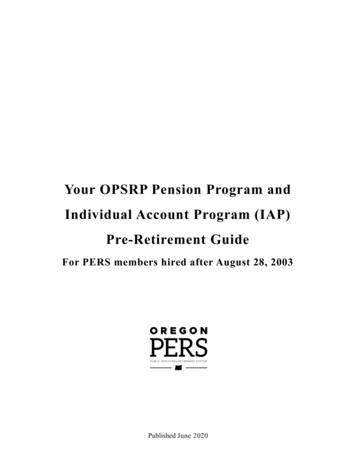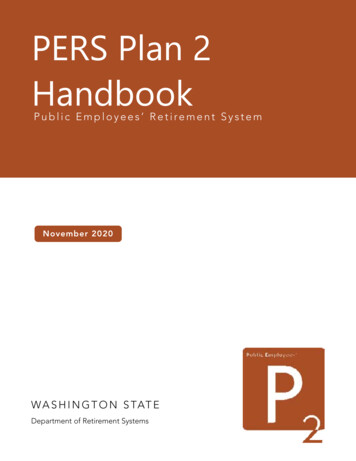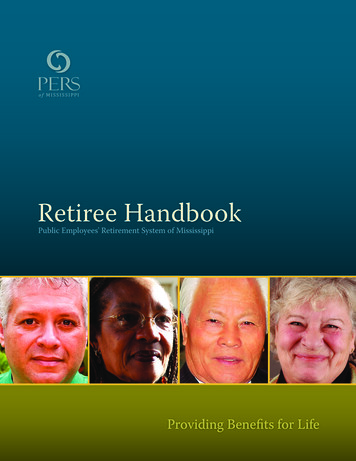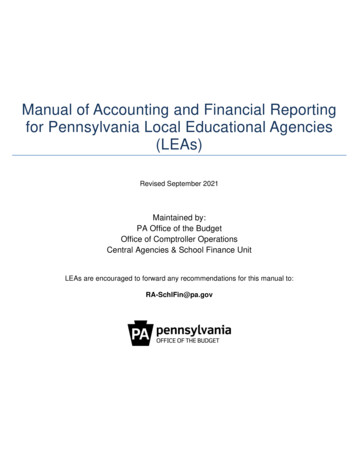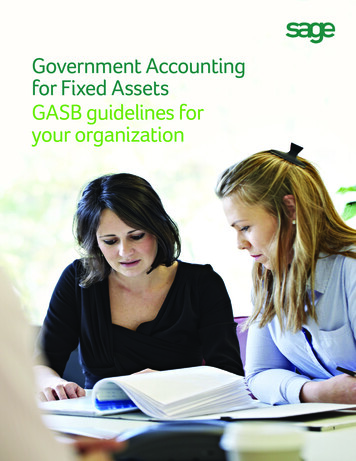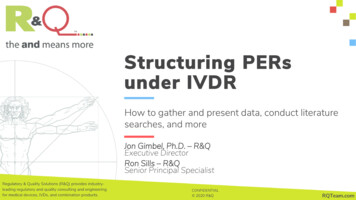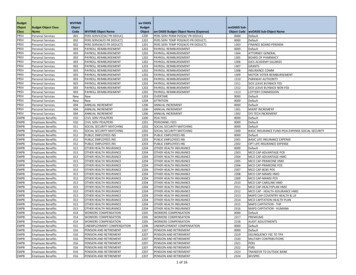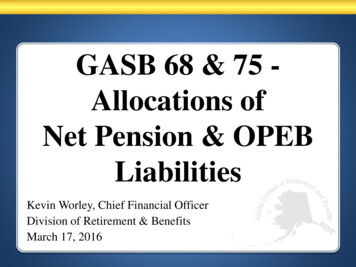
Transcription
GASB 68 & 75 Allocations ofNet Pension & OPEBLiabilitiesKevin Worley, Chief Financial OfficerDivision of Retirement & BenefitsMarch 17, 2016
TOPICS OF DISCUSSION AICPA SLGEP Census Data Guidance GASB #68 – Net Pension allocation report What is DRB providing to employers? When is DRB providing it? Special funding situation GASB #75 – Net OPEB allocation report
AICPA State & LocalGovernment Expert Panel(SLGEP)Testing Census Data onPLAN Financial Statements andImpact on Participating Employers
AICPA GuidanceCensus Data With the issuance of GASB No. 67, therewere questions related to the Total PensionLiability (TPL), contribution revenues, andcontribution receivables The Plan Auditor needs to assert that theabove are complete and accurate, and in orderto assert that, more audit work had to be doneon census data That’s why our external auditors now visityou
AICPA GuidanceCensus DataSome significant elements of census data include:1. Date of birth2. Date of hire / years of service3. Eligible compensation4. Class of employee – all other / Peace officer orfire fighter5. Gender6. Date of termination, if applicable
AICPA GuidanceCensus Data Plan auditors must review plan processes forthe census data of active employees of theplan and include procedures to verify theunderlying payroll records of participatingemployers to determine that the information isaccurate and complete Census data work by external auditor must becompleted prior to issuance of audit reports Letters out in May; work starts in June
AICPA GuidanceCensus Data Frequency and extent of verification is basedon participating employer size, percent ofcontributions, and impact on TPL Plan auditor identifies and assesses risk ofmaterial misstatement of elements Plan auditor selects representative group ofcontributing employers each year as well asindividually important employers Every year, as well as 5 and 10 year cycles
AICPA GuidanceWhite Papers and Audit Interpretations SLGEP Pension Whitepaper on IssuesAssociated with Testing Census Data in an Auditof Financial Statements SLGEP Pension Whitepaper on Issues Related toInformation for Employer Reporting Search for “SLGEP Pension Whitepaper Series”for these two reports Available on Division’s website
GASB Statement No. 68Accounting and Financial Reporting forPensions – An Amendment of GASB Statement#27
GASB No. 68Accounting & Financial Reporting for Pensions In June 2012, the GASB issued two newstandards changing the accounting andfinancial reporting requirements for pensions The intent of the standards is to enhance thepension-related information in financialreports by providing greater transparency andto standardize the valuation practices fromentity to entity in the financial reports(comparability)
GASB No. 68Accounting & Financial Reporting for Pensions Governments are now required to report itsproportionate share of unfunded pensionobligations on the financial statements Pension expense is the change in Net PensionObligation Increased note disclosures and schedules Measurement is accounting-based, notfunding-based
GASB No. 68Accounting & Financial Reporting for Pensions These are new accounting and financialstandards for reporting purposes, and will notimpact your funding requirements New reporting standards break the linkbetween actuarial funding and financialaccounting for pensions Under Alaska law, the current employerfunding requirement is the statutorily requiredcontributions
GASB No. 68Accounting & Financial Reporting for Pensions So, there is no change to the employercontribution rate based on this GASBstatement The new standards consider only how plansand employers account for and report pensioncosts GASB No. 68 Implementation Guide isavailable on-line
GASB No. 68Accounting & Financial Reporting for Pensions The Net Pension Liability is an accrualaccounting measurement calculated inconformity with GASB 67 / 68 The Unfunded Actuarial Accrued Liability(UAAL) in the actuarial valuation reports is afunding measure calculated according toActuarial Standards of Practice Two numbers used for two separate purposes:one is accounting, one is funding
GASB No. 68Accounting & Financial Reporting for Pensions The Division continues to work to ensure thatour participating employers are positioned toimplement GASB 68 The Division will use every outreach outletavailable to us including participating inconferences, group meetings, internet
GASB No. 68Accounting & Financial Reporting for Pensions PERS Net Pension Liability as of June 30,2015 to be allocated is 4,850,014,000(see page 33 of PERS FY 2015 audited f/s) TRS Net Pension Liability as of June 30,2015 to be allocated is 1,860,451,000(see page 32 of TRS FY 2015 audited f/s)
Special FundingSituation
Special Funding SituationGASB 68 DefinitionParagraph 15 defines circumstances in which anonemployer entity is “legally responsible” formaking contributions directly to a pension planthat is used to provide pensions to theemployees of another entity or entities andeither of the following conditions exist:
Special Funding SituationGASB 68 Definition(1) the amount of the contributions for whichthe nonemployer entity legally is responsible isnot dependent upon one or more events orcircumstances unrelated to pensions(2) the nonemployer entity is the only entitywith a legal obligation to make contributionsdirectly to a pension plan
Special Funding SituationGASB 68 DefinitionGASB clarified the term “legally responsible”for purposes of GASB 68 should not beconstrued in a legally enforceable sense, but inan “economic reality” sense, in that the State ismaking payments on behalf of participatingemployers pursuant to AS 39.35.280 and14.25.085.
Special Funding Situation From an accounting perspective, the State isrecording the special funding situation on itsbalance sheet From a legal perspective, the Stateaffirmatively disclaims any and all legalresponsibility or obligation, in a legallyenforceable sense, for the non-State employerGASB 68 net pension liabilities reported inthe State’s CAFR (See page 107 of State’sCAFR for footnote disclosure)
What is theDivision of Retirement & BenefitsProviding to Employers?
What is being provided?What do participating employers need? Employers will recognize the proportionateshare of cost-shared pension amounts(allocation of NPL) Challenges relate to each participatingemployer obtaining the necessary support ofNPL, deferred inflows/outflows of resources,and pension expense SLGEP recommended that the cost-sharingplans calculate each employer’s allocationand collective pension expense
What is being provided?Schedule of Employer Allocations From Page 5 of 9 – SLGEP Pension Whitepaper Series on Information for Employer Reporting
What is being provided?What makes up employer contributions? Employer contributions Past Service Cost contributions Salary Floor contributions DBUL contributions Imputed mandatory contributions Imputed DBUL contributions This schedule will be provided this year
What is being provided?Schedule of Pension Amounts by Employer From Page 7 of 9 – SLGEP Pension Whitepaper Series on Information for Employer Reporting
What is being provided?Audited Schedules The Division provided:1. audited schedules of employer andnonemployer allocations2. audited schedules of pension amounts byemployer and nonemployer
What is being provided?Supplemental Schedules The Division provided:1. supplemental schedules of employer andnonemployer amortization of deferredinflows and outflows The Division DID NOT provide:1. Footnote assistance – determined it felloutside the scope of fiduciary duty; GASB68 paragraph 74-82 describes requireddisclosures
What is being provided? Pension contributions made subsequent tomeasurement date are best handled by theemployer and recorded as a deferred outflowof resources Due to costs and State’s effort for costcontainment, the Division may have to figureanother way to prepare this report that isauditable and that provides the informationneeded by employers Very expensive to prepare and audit
When is theDivision of Retirement & BenefitsProviding the Informationto Employers?
When is it being provided? It is the intent of the Division to provide theGASB 68 (and associated 75 reports) in thespring of each year, no later than May thoughsooner would be much better for all parties It’s not all about the June 30 year endemployers, we also have September 30 andDecember 31 year ends too When applicable, they will be combined intoone report
Where is the Division ofRetirement & BenefitsInformation Located?
Where is it located?
Where is it located?What information is available Audited schedules PERS and TRS Schedules of Employer andNonemployer Allocations and Schedules ofPension Amounts by Employer and Nonemployer Actuary reports GASB 68 information report includes schedules,actuarial assumptions and methods, planprovisions, allocations of pension amounts, NPLreconciliation, and amortization schedules
GASB Statement No. 75Accounting and Financial Reporting forPostemployment Benefits Other Than Pensions
GASB No. 75OPEB Related These benefits are provided by both the PERSand TRS defined benefit plans as well as thedefined contribution plans Benefits involve health care benefits, but alsomay include life insurance, disability, legal,and other services (though not necessarilyprovided by PERS and TRS)
GASB No. 75OPEB StatementsIn June 2015, the GASB issued two statementsthat are designed to improve the usefulness ofinformation about OPEB1. Financial Reporting for PostemploymentBenefit Plans Other than Pension Plans(PLAN) – GASB 742. Accounting and Financial Reporting forPostemployment Benefits Other thanPensions (EMPLOYER) – GASB 75
GASB No. 75OPEB StatementsThese are very similar to the pension standards(GASB 67 and 68)1. OPEB is part of the employment exchange andshould be recognized as incurred, not funded2. The government-wide and full accrualstatements will report a “Net OPEB Liability”3. Change in Net OPEB Liability will beimmediately recognized in expense
GASB No. 75OPEB StatementsLike the pension statements before it, theOPEB statement is designed to improve theinformation reported on OPEB for decisionmaking and accountability purposes,comparability across governments, andtransparency
GASB No. 75OPEB Statements Intended to lead to fundamental changes in howOPEB is accounted for and reported Accounted for in a trust with specific criteriawhere contributions are irrevocable, assets arededicated to providing OPEB to plan members,and plan assets are legally protected Provide a more comprehensive picture of whatstate and local governments have promised andthe actual associated costs
GASB No. 75OPEB StatementsAddresses a number of issues: Affects how the long-term obligation and theannual costs of OPEB are measured Recognize the net OPEB liability on the faceof the financial statements Present more extensive note disclosures andrelated schedules
GASB No. 75OPEB StatementsMeasurement date (PLAN): Measured as of the plan’s year end The actuarial valuation may be performedearlier (within 24 months) and then rolledforward to the PLAN’s fiscal year endreporting date FORMULA is TOTAL OPEB LIABILITY –OPEB Plan Net Position Net OPEBLiability
GASB No. 75OPEB StatementsNote and RSI Changes (EMPLOYER): Significant footnote disclosures – like pension RSI requirements – 10 years1. Schedule of proportionate share of NetOPEB liability2. Schedule of contributions3. Notes to RSI
GASB No. 75Effective Date Fiscal years beginning AFTER June 15, 2017 The Division would prepare the first OPEBallocation schedule for Fiscal Year June 30,2018 This would mean the Division would provideOPEB allocation schedule as of June 30, 2017in the Spring of 2018, as well as the Pensionallocation
GASB No. 75Lessons Learned from GASB No. 68 Timing of release of audited report Contact with participating employers More information available, like support ofemployer contributions used for allocationpercentage
What do you want toknow more about?E-mail: Kevin.Worley@alaska.govPhone: (800) 821-2251 outside Juneau465-4460 in Juneau
Thank you for your time andattention!
GASB clarified the term "legally responsible" for purposes of GASB 68 should not be construed in a legally enforceable sense, but in an "economic reality" sense, in that the State is making payments on behalf of participating employers pursuant to AS 39.35.280 and 14.25.085.
